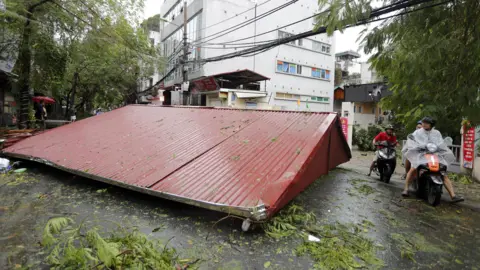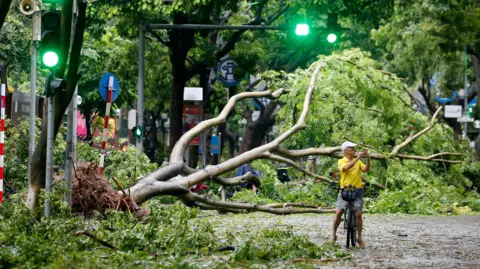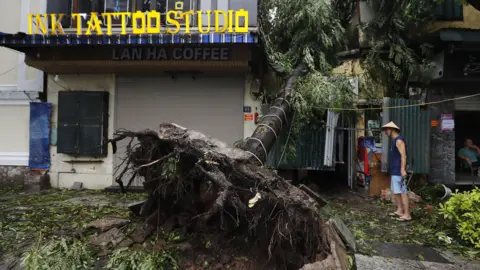Typhoon Yagi kills 59, injures hundreds in Vietnam
Written by BBC on September 9, 2024
Super typhoon Yagi, Asia’s most powerful storm this year, has killed at least 59 people and injured hundreds in northern Vietnam, according to local authorities.
At least 44 victims were killed by landslides, the country’s Ministry of Agriculture and Rural Development said on Monday.
Yagi, which made landfall in Vietnam on Saturday, has been downgraded to a tropical depression, but authorities have warned of more flooding and landslides as the storm moves westwards.
Among the victims were four family members who died after parts of a hill collapsed onto their house in the mountainous Hoa Binh province on Sunday.
A 51-year-old man was able to escape while his wife, daughter and two grandchildren were buried. Their bodies were recovered later, AFP news agency reported.
State media reported that a landslide in Sa Pa, in the northern mountainous Lao Cai province, occurred around noon on Sunday, burying 17 people. Six of them have since been found dead, with nine others left injured.
A 68-year-old woman, a one-year-old boy and a newborn baby were among those said to be killed.
After Yagi made landfall in northern Vietnam on Saturday, the storm hit Hai Phong and Quang Ninh provinces with winds of up to 203 km/h (126 mph), the Indo-Pacific Tropical Cyclone Warning Centre said.
It lifted roofs from buildings and uprooted trees, leading to power outages across the region, including in the capital, Hanoi.
Videos online showed car drivers slowing down to shield motorbike riders trapped on the roads due to strong winds.
State media said four people died in the northern Quang Ninh province, with another killed in Hai Duong, near Hanoi.
A bridge in the northern Phu Tho province collapsed on Monday morning, plunging 10 cars and two scooters into the Red River, according to Deputy Prime Minister Ho Duc Phoc. Local media reported that at least three people had been rescued and 13 were missing. It is unclear if there were casualties as a result of the bridge collapse.
Footage online showed part of the bridge still standing, while the collapsed sections were swept away in the raging river.

A metal roof seen laying on the ground after strong winds hit the capital, Hanoi.
Some 41 fishing boats are among vessels sunk or adrift in the wake of the storm. Search and rescue personnel found 27 people drifting at sea after a dozen fishermen were reported missing.
In the port city of Hai Phong, several areas were under half a metre (1.6 feet) of flood waters on Sunday, with power lines and electrical poles damaged, according to AFP.
Metal roof sheets and commercial sign boards were seen flying across the city of two million, which faced the brunt of the storm.
Power outages hit parts of Hai Phong – home to multinational factories – on Saturday, while four of north Vietnam’s airports suspended operations for much of the day.
At the Hai Au boat lock on Tuan Chau island, north of Hai Phong, at least 23 boats were seriously damaged or sunk, according to local residents.
51-year-old sailor Pham Van Thanh told AFP he had never experienced such a strong and violent typhoon.
He said all the crew had remained on board his tourist boat since Friday to stop it from sinking.
“The wind was pushing from our back, with so much pressure that no boat could stand,” he told AFP.
“Then the first one sank. Then one after another.”

Fallen trees are seen across the streets in Hanoi.
Nearly 50,000 people have been evacuated from coastal towns in Vietnam, with authorities issuing a warning to remain indoors.
Schools were temporarily closed in 12 northern provinces, including Hanoi.
Duong The Hung, a restaurant owner in Ha Long Bay, a Unesco world Heritage site, said his business’s signs had all fallen off.
“The ceiling has collapsed. The metal roof needs repairs. The damage is severe.”
The storm is expected to move into northernmost Laos by Sunday evening.

Thousands were uprooted after Yagi struck.
Before hitting Vietnam on Saturday, the typhoon brought devastation to the Chinese island of Hainan – a popular tourist destination dubbed China’s Hawaii – and to the Philippines, killing at least 24 people and injuring dozens of others, AFP reported.
On Friday, China evacuated some 400,000 people in Hainan island. Trains, boats and flights were suspended, while schools were shut.
Local media there reported widespread power outages, with about 830,000 households affected. Valuable crops have also been wiped out.
A super typhoon is equivalent to a Category 5 hurricane.
Scientists say typhoons and hurricanes are becoming stronger, more frequent and staying over land for longer due to climate change. Warmer ocean waters mean storms pick up more energy, which leads to higher wind speeds.
A warmer atmosphere also holds more moisture, which can lead to more intense rainfall.
Additional reporting by Aleks Phillips, Lipika Pelham and Kelly Ng




